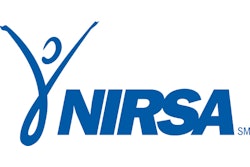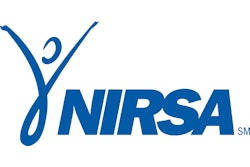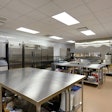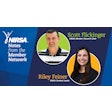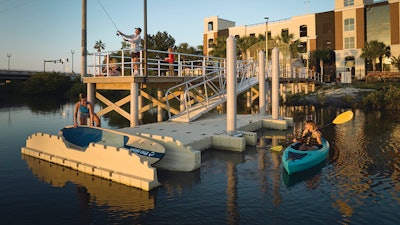
Alicia Ramsdell knows what it’s like to run a campus recreation program with limited resources. In some ways, she says, it’s not that much different than overseeing one at a larger university.
“Sometimes, the challenges at small schools are a bit different than those at larger schools, and sometimes they’re exactly the same — just on a smaller scale,” says Ramsdell, director of campus recreation at St. Augustine, Fla.’s Flagler College, where total enrollment is 2,100. Her department has just three full-time staff members.
She also is chair of NIRSA’s Small Programs Committee. This group organized a roundtable discussion at the 2024 NIRSA Annual Conference and Campus Rec & Wellness Expo in April. There, 75 campus recreation professionals from 50 or so small colleges and universities exchanged ideas with each other.
“The goal was to hear what others are doing in specific areas,” Ramsdell says. “What works for them? How are they thinking outside the box? What are some groups on campus they’re collaborating with so they’re not doing it all by themselves?”
Chris Crume, who balances several roles as director of aquatics, intramurals and recreation at Denison University in Granville, Ohio, which has an enrollment of about 2,400, says his day to day is always a juggling act. “One of the biggest challenges is that there’s never enough time for me to give everything 100 percent of the attention that it needs,” says Crume. “I’m not a full-time campus rec person, but I am the closest we have to one. I rely a lot on my intramural and aquatics student supervisors. I can’t be everywhere all the time, so I give them a lot of trust and responsibility, and that makes the programs work.”
Crume spent five years as assistant director of aquatics at Purdue University before arriving at Denison a dozen years ago. He admits to making a bold move, but he also saw value in spearheading a small program. “I get to try and do a lot of different things that expand who I am as a professional, and that’s why I jumped at the opportunity to come here,” he says. “Students on small-program campuses need just as much of a campus recreation experience as those on large-program campuses. And a lot of times, there’s only one, two or maybe three of us on a campus to provide that, so you need to be tenacious in trying new things and forging partnerships.”

‘Come up with a big idea’
Until 2021, Flagler’s campus recreation fitness facilities were shared with athletics. When the Bailey Fitness Center opened and programming expanded, the number of student employees in the campus recreation department climbed from just a handful to about 50. That transition proved to be a challenging one, especially given the number of high-paying jobs available to college-age workers at gift shops, hotels and other hospitality-related businesses in touristy St. Augustine.
Ramsdell and her staff began heavily emphasizing the benefits of working at the fitness center, including the development of strong communication and customer service skills. Previously, that wasn’t necessary because there weren’t many campus recreation jobs available, Ramsdell says, adding that she also dug deeper into her department’s data analytics and discovered lulls in facility usage that allowed her to shift hours and utilize student workers more effectively.
The fitness center became a catalyst for not only Ramsdell and her staff but also for Flagler’s upper administration to look beyond what had previously worked for campus recreation — primarily intramurals. In summer 2022, the college built a dock on the shore of a river that flows through part of campus. Kayaking, paddleboarding and fishing are now part of an increasingly popular campus water sports program.
“It’s all about strong leadership and people seeing the value in what we do,” Ramsdell says. “We’re also growing our outdoor program with hiking and camping activities, but our biggest growth has been in water sports.”
The dock is a perfect example of bridging the resources and programming gap that exists between larger and smaller schools, but it’s still a gap that sometimes seems like it will never narrow. “I think a lot of the things that bigger schools are doing aren’t as far out of reach as they seem,” Ramsdell says. “Don’t be afraid to come up with a big idea and find ways to make it a reality with the resources you have.”
 Photo by Chris Clume courtesy of Denison University
Photo by Chris Clume courtesy of Denison University
‘I love being in a small program’
At Denison, campus recreation is housed in the Mitchell Recreation and Athletics Center, where students have access to a three-court gymnasium, two grass fields and — for intramural flag football championships — the synthetic turf at Deeds Field – Piper Stadium.
“If you get creative, you can still offer the same level of quality and service that’s at a bigger institution,” Crume says. “I reach out to my student-life colleagues all the time. We recently partnered to bring one of the university’s student involvement fairs to our space, which helped get students in the door and understand that the Mitchell Center is not just for student athletes. It’s for everyone.”
That January event — in which the university’s Alford Community Leadership & Involvement Center brought together more than 150 campus organizations under the Mitchell Center roof — was so successful that it likely will be held again in 2025, according to Crume. Denison’s campus recreation department also has worked with the university’s Office of First-Year Experience to provide opportunities during new student orientations for evening basketball, dodgeball and other activities.
In today’s highly competitive collegiate landscape, such cross-campus partnerships can help programs of all sizes survive and thrive — but especially those on small campuses.
“Reach out to colleagues in other parts of campus and ask, ‘How can we be part of what you’re doing and help make you more successful, which in turn will make us more successful?’ ” Crume says. “For example, whether I’m with our athletic director, student-life colleagues or professors, I can speak their language when talking about what we’re trying to accomplish and what they’re trying to accomplish. It’s a unique experience that you don’t always get everywhere else, and it’s how you survive in a small program.”
Crume also says current students and professionals striving to build a career in campus recreation shouldn’t worry about starting out small.
“When I’m at the annual conference and talking with students or professionals, I always encourage them to consider a small school — because the breadth of experience you’re going to get will be invaluable,” he says. “Maybe you’re going in as a fitness and wellness person at a small program, but I guarantee you’re going to have opportunities to dabble in other areas and make yourself a more well-rounded campus rec professional. I feel like that’s super valuable. I love being in a small program.”




















